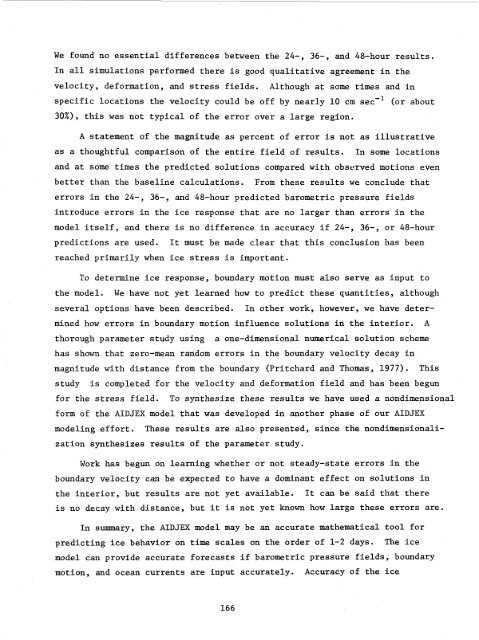AIDJEX Bulletin #40 - Polar Science Center - University of Washington
AIDJEX Bulletin #40 - Polar Science Center - University of Washington
AIDJEX Bulletin #40 - Polar Science Center - University of Washington
You also want an ePaper? Increase the reach of your titles
YUMPU automatically turns print PDFs into web optimized ePapers that Google loves.
We found no essential differences between the 24-, 36-, and 48-hour results.<br />
In all simulations performed there is good qualitative agreement in the<br />
velocity, deformation, and stress fields. Although at some times and in<br />
specific locations the velocity could be <strong>of</strong>f by nearly 10 cm sec-l (or about<br />
30%), this was not typical <strong>of</strong> the error over a large region.<br />
A statement <strong>of</strong> the magnitude as percent <strong>of</strong> error is not as illustrative<br />
as a thoughtful comparison <strong>of</strong> the entire field <strong>of</strong> results. In some locations<br />
and at some times the predicted solutions compared with observed motions even<br />
better than the baseline calculations. From these results we conclude that<br />
errors in the 24-, 36-, and 48-hour predicted barometric pressure fields<br />
introduce errors in the ice response that are no larger than errors in the<br />
model itself, and there is no difference in accuracy if 24-, 36-, or 48-hour<br />
predictions are used. It must be made clear that this conclusion has been<br />
reached primarily when ice stress is important.<br />
To determine ice response, boundary motion must also serve as input to<br />
the model. We have not yet learned how to predict these quantities, although<br />
several options have been described. In other work, however, we have determined<br />
how errors in boundary motion influence solutions in the interior. A<br />
thorough parameter study using a one-dimensional numerical solution scheme<br />
has shown that zero-mean random errors in the boundary velocity decay in<br />
magnitude with distance from the boundary (Pritchard and Thomas, 1977). This<br />
study is completed for the velocity and deformation field and has been begun<br />
for the stress field. To synthesize these results we have used a nondimensional<br />
form <strong>of</strong> the <strong>AIDJEX</strong> model that was developed in another phase <strong>of</strong> our <strong>AIDJEX</strong><br />
modeling effort. These results are also presented, since the nondimensionalization<br />
synthesizes results <strong>of</strong> the parameter study.<br />
Work has begun on learning whether or not steady-state errors in the<br />
boundary velocity can be expected to have a dominant effect on solutions in<br />
the interior, but results are not yet available. It can be said that there<br />
is no decay with distance, but it is not yet known how large these errors are.<br />
In summary, the <strong>AIDJEX</strong> model may be an accurate mathematical tool for<br />
predicting ice behavior on time scales on the order <strong>of</strong> 1-2 days. The ice<br />
model can provide accurate forecasts if barometric pressure fields, boundary<br />
motion, and ocean currents are input accurately. Accuracy <strong>of</strong> the ice<br />
166








